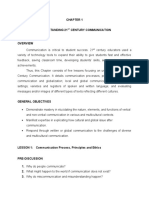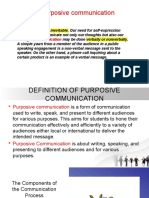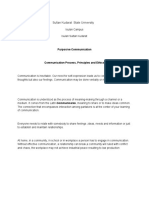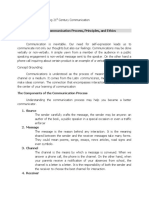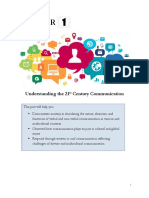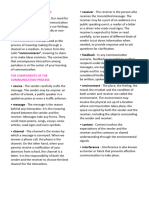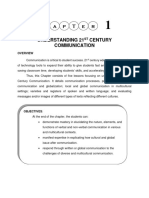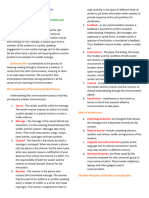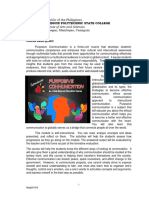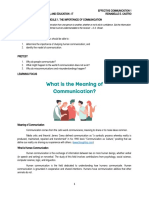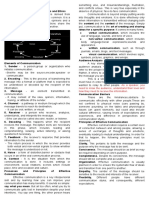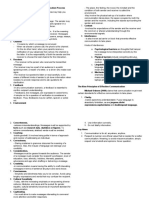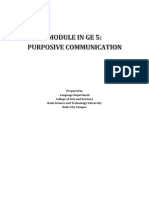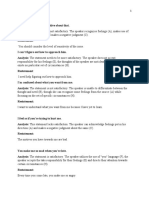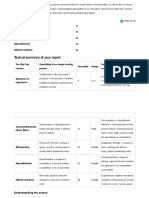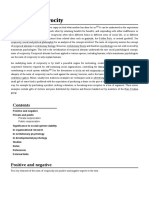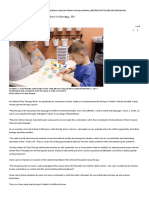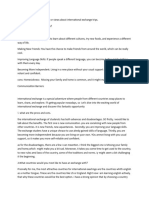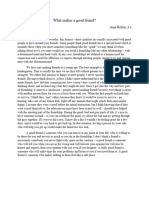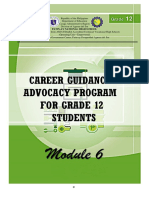Purposive Communication Module Unit 1 8
Uploaded by
janiah reyn SadavaPurposive Communication Module Unit 1 8
Uploaded by
janiah reyn SadavaENG 1: Purposive Communication 1
ENG 1:
Purposive
Communication
RICHLLE B. VILLASIS, LPT | COLLEGE OF ENGINEERING, URS ANTIPOLO
ENG 1: Purposive Communication 2
Unit 1: COMMUNICATION PROCESS, PRINCIPLES AND ETHICS
WHAT TO EXPECT?
● Explain the principles, process, and ethical considerations in communication, focusing on the
components of the communication process and barriers to effective communication.
● Elucidate how communication skills, particularly active listening techniques, can help resolve
problems, better understand new concepts, and aid in professional settings.
● Apply the knowledge of the communication process in creating impactful messages and
improving overall communication skills.
PRE-DISCUSSION
1. Why do people communicate?
2. What might happen to the world if communication does not exist?
3. Why do miscommunication and misunderstanding happen?
LESSON OUTLINE
Why we communicate?
In purposive communication, we communicate to achieve specific goals, like sharing
information, persuading others, or building relationships. The ultimate aim is to convey messages
effectively and fulfill particular needs or objectives.
The nature of communication
The nature of communication is the exchange of information between two people. It is required
that there be both a sender and a receiver for communication to take place. Communication is
reciprocal. So, at any time the sender is sending a message the receiver is also sending messages.
Communication is inevitable. Our need for self-expression leads us to communicate not only our
thoughts but also our feelings. Communication may be done verbally or nonverbally. A simple yawn
from a member of the audience in a public speaking engagement is a non-verbal message sent to the
speaker. On the other hand, a phone call inquiring about a certain product is an example of a verbal
message.
Communication is understood as the process of meaning-making through a channel or a
medium. It comes from the Latin term communicares, meaning to share or to make ideas common. The
connection that encompasses interaction among partakers is at the center of your learning of
communication.
RICHLLE B. VILLASIS, LPT | COLLEGE OF ENGINEERING, URS ANTIPOLO
ENG 1: Purposive Communication 3
The Components of the Communication Process
Understanding the communication process may help you become a better communicator.
1.Source. The sender carefully crafts the message. The sender may be anyone: an author of a
book, public speaker on a special occasion or even a traffic Enforcer.
2.Message. The message is the reason behind any interaction. It is the meaning shared between
the sender and the receiver.
3.Encoding. The process of transferring the message.
4.Channel. The channel is the means by which the message is conveyed. When we answer a
phone call, the phone is the channel. On the other hand, when your parents receive a notification of
your absences from school, the channel is the letter. It is the responsibility of both the sender and the
receiver to choose the best channel for the interaction.
5. Decoding. The process of interpreting the encoded message.
6. Receiver. The receiver is the person who receives the transmitted message. The receiver may
be a part of the audience in a public speaking event, a reader of the letter o a driver who reads the road
signs. The receiver is expected to listen or read carefully, to be aware of different kinds of sender to joy
down information when needed, to provide response and to ask questions for clarification.
7. Feedback. In any communication scenario, feedback is essential to confirm recipient
understanding. Feedbacks, like messages, are expressed in varied forms. A simple nod for a question of
verification is considered feedback. Thus, feedback may be written, spoken or acted out.
8. Environment. The place, the feeling, the mood, the mindset and the condition of both sender
and receiver are called the environment. The environment may involve the physical set-up of a location
where communication takes place, the space occupied by both the sender and the receiver, including
the objects surrounding the sender and receiver.
9. Context. This involves the expectations of the sender and the receiver and the common or
shared understanding through the environmental signals. (Context in communication refers to the
circumstances and background information that surround and influence a message.)
10. Interference. This is also known as a barrier or block, prevents effective communication to
take place.
RICHLLE B. VILLASIS, LPT | COLLEGE OF ENGINEERING, URS ANTIPOLO
ENG 1: Purposive Communication 4
The Communication Process
Barriers to effective communication (Kinds of Interference in Communication)
a. Psychological barriers are thoughts that hamper the message to be interpreted correctly by the
receiver. This may include past experiences.
b. Physical barriers include competing stimulus, weather and climate, health and ignorance of the
medium.
c. Physiological barriers refer to physical or biological conditions that affect a person's ability to receive,
process, or produce messages. (The normal function of the living things and its parts.)
d. Linguistic and cultural barriers pertain to the language and its cultural environment. Words may mean
another in different cultures.
e. Mechanical barriers are those raised by the channels employed for interpersonal, group or mass
communication. These include cell phones, laptops and other gadgets used in communication.
The Nine Principles of Effective Communication
Michael Osborn (2009) claims that communication must meet certain standards for effective
communication to take place.
1. Clarity.
This makes speeches understandable. Fuzzy language is absolutely forbidden, as are jargons, cliché
expression, euphemism and doublespeak language.
RICHLLE B. VILLASIS, LPT | COLLEGE OF ENGINEERING, URS ANTIPOLO
ENG 1: Purposive Communication 5
2. Concreteness.
This reduces misunderstandings. Messages must be supported by facts such as research data, statistics
or figures. To achieve concreteness, abstract words must be avoided.
3. Courtesy.
This builds goodwill. It involves being polite in terms of approach and manner of addressing an
individual.
4. Correctness.
Glaring mistakes in grammar obscure the meaning of a sentence. Also, the misuse of language can
damage your credibility.
5.Consideration.
Message must be geared towards the audience. The sender of a message must consider the recipient’s
profession, level of education, race, ethnicity, hobbies, interest, passion, advocacies, and age when
drafting or delivering a message.
6.Creativity.
This means having the ability to craft interesting message in terms of sentence structure and word
choice.
7. Conciseness.
Simplicity and directness help you to be concise. Avoid using lengthy expressions and words that may
confuse the recipient.
8. Cultural Sensitivity.
Today, with the increasing emphasis on empowering diverse cultures, lifestyle and races and pursuit for
gender equality, cultural sensitivity becomes an important standard for effective communication.
9. Captivating.
You must strive to make messages interesting to command more attention and better responses.
RICHLLE B. VILLASIS, LPT | COLLEGE OF ENGINEERING, URS ANTIPOLO
ENG 1: Purposive Communication 6
The Art of Listening
Active listening involves fully engaging with the speaker, focusing on their words, and
demonstrating genuine interest. By honing this skill, individuals can enhance their communication
abilities, build stronger relationships, and create a positive impact on those around them.
The Fundamentals of Active Listening
Active listening goes beyond merely hearing the words spoken by someone. It involves paying
attention, comprehending, and responding appropriately to the speaker’s message. By
employing the following techniques, individuals can become adept at active listening:
1. Give Undivided Attention: When engaging in a conversation, eliminate distractions and
redirect your focus entirely to the speaker. Maintain eye contact, nod occasionally to show
understanding, and avoid interrupting. This demonstrates respect and reinforces the speaker’s
confidence in sharing their thoughts.
2. Practice Empathy: Put yourself in the speaker’s shoes and try to understand their perspective.
Empathy allows you to connect on a deeper level and appreciate their emotions, concerns, and
experiences. By acknowledging their feelings, you create a safe space for open and honest
dialogue.
3. Ask Open-Ended Questions: Encourage the speaker to expand on their thoughts by asking
open-ended questions. These questions invite detailed responses and help you gain a deeper
understanding of their ideas or feelings. For example, instead of asking, “Did you enjoy the
event?” ask, “What did you find most interesting about the event?”
4. Reflect and Paraphrase: Summarize the speaker’s message periodically to ensure accurate
comprehension. Reflect their words back to them to show that you are actively listening and
understanding their point of view. This technique not only confirms your understanding but also
allows the speaker to clarify or elaborate on their thoughts.
Reasons for Listening
- To understand, learn, build relationships, solve problems, and make informed decisions.
1. Types of Listeners:
a) Active Listener: Fully engages with the speaker, providing feedback and clarifying
understanding through verbal and non-verbal cues.
b) Passive Listener: Listens without much engagement or response, often missing nuances and
deeper meaning.
c) Selective Listener: Focuses only on certain parts of the conversation that interest them,
ignoring other aspects.
d) Empathetic Listener: Listens with the intent to understand and share the speaker’s emotions
and perspectives.
e) Critical Listener: Analyzes and evaluates the content of the message for accuracy, logic, and
validity.
RICHLLE B. VILLASIS, LPT | COLLEGE OF ENGINEERING, URS ANTIPOLO
ENG 1: Purposive Communication 7
2. Types of Listening:
a) Informational (to gain information),
b) critical (to evaluate and analyze),
c) empathic (to understand emotions), and;
d) reflective (to clarify and confirm understanding).
3. Ethics of Oral Communication: Honesty, respect, clarity, fairness, and sensitivity.
4. The Ethical Speaker: Aims to be truthful, respectful, and clear, avoiding manipulation and
misinformation.
5. The Ethical Listener: Practices active listening, shows respect, avoids prejudgment, and provides
constructive feedback.
SUMMARY
Communication is defined as the process of transmitting information and common
understanding from one person to another. Communication follows a process. There are 8 elements of
communication: (a) Source; (b) Message; (c) Channel; (d) Receiver; (e) Feedback; (f) Environment; (g)
Context; (h) Interference. Principles are considered in the communication process. These principles will
ensure effectiveness along the communication process.
It covers the nature of communication as an inevitable exchange of information between sender
and receiver, emphasizing its reciprocal nature. The unit delves into the components of the
communication process, including source, message, encoding, channel, decoding, receiver, feedback,
environment, context, and interference. It also discusses barriers to effective communication, such as
psychological, physical, linguistic, cultural, and mechanical obstacles. The nine principles of effective
communication are outlined, including clarity, concreteness, courtesy, correctness, consideration,
creativity, conciseness, cultural sensitivity, and captivation. Additionally, the unit explores active
listening techniques, types of listeners, and the ethics of oral communication. Overall, the unit aims to
enhance students' understanding of communication processes and improve their ability to communicate
effectively.
RICHLLE B. VILLASIS, LPT | COLLEGE OF ENGINEERING, URS ANTIPOLO
ENG 1: Purposive Communication 8
Unit 2: COMMUNICATION AND GLOBALIZATION
TABLE OF CONTENTS
A. Introduction
B. International Communication and Globalization: Contradictions and Directions
C. Communication and the Globalization Process in the Developing World
D. International Communication: The Control of Difference and Global Market
E. Language Globalization and the Workplace: Education and Social Implications
LESSON OUTLINE
A. INTRODUCTION
What is Communication?
• Communication is a process of sending and receiving information between two or
more people.
• Communication is a process wherein two people exchange information.
What is International Communication?
• International communication refers to the exchange of information and ideas
between individuals, organizations, or nations across different countries and
cultures, "means beyond the borders communication."
• International Communication - Refers to how information exchange across
geographical and social divides, as well as how communication both impacts and is
influenced by culture, politics, media, economies, health, and relationships in the
age of globalization.
• International Communication - Examines how information is exchanged across
geographical and social divides, as well as how communication both impacts and is
influenced by culture, politics, media, economies, health, and relationships in the age
of globalization.
RICHLLE B. VILLASIS, LPT | COLLEGE OF ENGINEERING, URS ANTIPOLO
ENG 1: Purposive Communication 9
What is Globalization?
• Globalization is the growing interdependence of the world's economies, cultures, and
populations, brought about by cross-border trade in goods and services, technology,
and flows of investment, people, and information.
• Globalization is a process of interactions and integration of other companies,
businesses, and people from other countries or nations
Globalization in Communication
• Globalization is a process of integration and interaction between people, companies,
and governments globally through international trade and investment, aided by
information technology. Global communication describes how countries and people
interact and integrate as things become globalized through contact. Globalization
creates a global communication system, reflecting the new reality where everybody is
connected to everybody and everybody depends on and is responsible for everybody.
• Globalization communication - Refers to the freedom of movement of ideas,
information, images, and reporters.
Importance of Communication
• Communication is the foundation of any relationship, human-animals-plants-the
cosmos.
• It enables us to express our emotions, our feelings, as well as our knowledge and
ideas.
• To express something
• For awareness
• To achieve goal
• To highlight issues
• For development
• For education
• For entertainment
RICHLLE B. VILLASIS, LPT | COLLEGE OF ENGINEERING, URS ANTIPOLO
ENG 1: Purposive Communication 10
B. INTERNATIONAL COMMUNICATION AND GLOBALIZATION: CONTRADICTIONS
AND DIRECTIONS
Contradiction
International Communication promotes global cultural exchange but can lead to cultural
homogenization, threatening local identities. While it increases access to information globally,
the digital divide leaves many regions disconnected. It fosters collaboration across borders but
can also spread misinformation and cause tensions between openness and government control.
Similarly, it empowers marginalized voices but can reinforce global power imbalances. These
contradictions reflect the complexities of a world increasingly connected through
communication.
Globalization promotes connectivity, but it can also result in homogenization of culture, where
dominant cultures replace local traditions. Tension grows between both national and international
identities as an outcome.
Though globalization brought positive changes towards international communications, it is
important to address the negatives as well. Issues such as global stratification and digital divide
is one of the most common down side of international communication.
- Cultural homogenization - this is the reduction of cultural diversity through
diffusion. It happens not only in the physical aspects but also to customs, ideology,
and values.
- Threat of local identities - Devalued status of localities and not getting enough
support from the community.
- Digital divide - a gap between people who access to contemporary information,
communication, and technology and those who do not. The more of the way of life
improves, the more people and culture fail to adapt to these changes.
- Spread of false and misinformation - fake news, Information that has no credibility,
and misleading information.
- Global stratification - Refers to unequal distribution of power and privilege. Includes
division of global status and social hierarchy.
- Deculturation - process by which a culture loses its cultural identity due to contact
with other cultures. Includes domination of culture and lost and destruction of
culture.
RICHLLE B. VILLASIS, LPT | COLLEGE OF ENGINEERING, URS ANTIPOLO
ENG 1: Purposive Communication 11
Direction
International communication is moving towards greater digital inclusion to bridge global
disparities in technology access, emphasizing cultural sensitivity to preserve diversity, enforcing
ethical media practices, promoting sustainability, and embracing technological innovations that
reshape how information is shared globally.
As international communication moves toward innovation it improves and speed up the
process of globalization through internet and mass media. This is great for mass cultural
exchange, acting as bridge for people around the world.
The globalization of communication often follows economic and military trends,
meaning that as economies and military powers expand, so does the flow of ideas and
information.
- Cultural Diversity - refers to appreciating society as a group of people with
different skills, talent, and needs. Includes coexisting with harmony and embracing
diversity
- Cultural Sensitivity - understanding of other’s beliefs and values despite of their
ethnicity and racial background. Also, it agrees to modify behavior to
accommodate other’s beliefs
- Media Ethics - refers to the set of rules that governs the behavior of individual in
the internet. This includes being accountable for one’s actions in the internet.
- Digital Equity - equal opportunity to access the information, technology, and the
internet.
- Sustainability and Cultural practices – it includes maintaining cultural beliefs,
practices conservation, and preservation and safeguarding of cultural heritage
C. COMMUNICATION AND GLOBALIZATION PROCESS IN THE DEVELOPING
WORLD
Against a background of rapid technological change, the impact of global communication
on national cultures and societies has become a dynamic area of critical enquiry. International
Communication and Globalization offers a timely overview of the rapidly expanding area of
media and communication studies. Leading contributors offer a range of perspectives on the
relationship between the process of globalization and international communication. Individual
RICHLLE B. VILLASIS, LPT | COLLEGE OF ENGINEERING, URS ANTIPOLO
ENG 1: Purposive Communication 12
chapters examine the impact of market relations, deregulation and technology of Third World
countries, as well as the ethics of the global communications industry. International
Communication and Globalization makes an important intervention in current debates about
media, technology and society.
The purpose of this chapter is to examine the rapid process of globalization, its impact
on the countries of the developing world and the changes which have emerged in the
communication and cultural policies of these countries.
- Rapid Technological Changes - due to rapid technological changes of society, the
impact of global communication results in national cultures and societies becomes the
spotlight of information. Leading contributors offer a range of perspectives on the
relationship between the process of globalization and international communication.
- Individual - individual chapters examine the impact of market relations, deregulation,
and technology of Third World countries, as well as the ethics of the global
communications industry.
- International - international communication and globalization makes an important
intervention in current debates about media, technology and society.
Different Types of Globalization
- Economic Globalization - Economic refers to the increasing integration of
international trade and investment in global economies.
- Political Globalization - Strengthen ties between nations through various
agreements and institutions to promote peace and cooperation.
- Social Globalization - The measure of how easily information and ideas pass
between people in their own country and between different countries.
D. INTERNATIONAL COMMUNICATION: THE CONTROL OF DIFFERENCE AND
GLOBAL MARKET
International communication, in the context of "the control of difference and global market,"
refers to the strategies and practices used to manage and navigate cultural, linguistic, and
ideological differences in global interactions. It encompasses how organizations and
governments communicate across borders to establish connections, influence perceptions, and
facilitate trade. This control aims to harmonize diverse perspectives while promoting
collaboration in the global market, ultimately fostering understanding and minimizing conflicts
in international relations and commerce.
RICHLLE B. VILLASIS, LPT | COLLEGE OF ENGINEERING, URS ANTIPOLO
ENG 1: Purposive Communication 13
Explores how communication strategies manage cultural differences and influence global
markets. It delves into the dynamics of globalization, emphasizing the role of media and
technology in shaping perceptions and interactions across borders. Those factors are:
- Political system - A political climate that was once closed to market forces, including
direct and indirect investment, may change over time.
- Legal system - Legal systems also vary across the planet and come in many forms. Some
legal systems promote the rule of law while others promote the rule of culture, including
customs, traditions, and religions.
- Economic system - Economic systems vary in similar ways across cultures, and again
reflect the norms and customs of people.
- Ethical system - Ethical systems, unlike political, legal, and economic systems, are
generally not formally institutionalized.
- Global Village - The global village refers to the idea that modern telecommunications
have made the world more interconnected, interdependent, and accessible.
E. LANGUAGE GLOBALIZATION AND THE WORKPLACE: EDUCATION AND SOCIAL
IMPLICATIONS
Language Globalization
Language globalization refers to the process by which certain languages spread and
become widely used across different countries and cultures. This often happens due to factors
like international trade, media, technology, and migration. As a result, languages, especially
English are spoken by people all over the world, making communication easier but also impacting
local languages and cultures.
Language globalization is the process where certain languages, like English, spread and
become widely used across different countries and cultures. This happens due to various factors,
including international trade, the influence of media, advancements in technology, and migration
patterns. As a result, these languages gain influence, leading to increased communication across
borders. However, this process can also have a significant impact on local languages and cultures.
Here are the breakdowns of this implications:
• Workplace Implication - refer to the effects and considerations of communication
practices within a professional environment. This includes how effective communication
RICHLLE B. VILLASIS, LPT | COLLEGE OF ENGINEERING, URS ANTIPOLO
ENG 1: Purposive Communication 14
can enhance teamwork, improve productivity, influence leadership styles, and impact
employee relations and organizational culture.
• Educational Implications – It involves the impact of communication methods on
teaching and learning processes. This encompasses how communication strategies affect
student engagement, understanding, collaboration among educators, and the overall
effectiveness of educational programs.
o Education plays a crucial role in equipping individuals with the necessary
language skills, while social implications include the potential for language
dominance, cultural erosion, and the need for inclusivity.
o Enhanced career prospects: Proficiency in multiple languages, especially English,
is becoming increasingly valuable in the global job market.
o Increased access to information and knowledge: Language skills open doors to
students to a wider range of resources, including academic publications,
research findings, and online learning materials
• Social Implications - pertain to the consequences of communication in societal contexts.
This includes how communication shapes social interactions, community relationships,
cultural understanding, and public discourse, influencing social norms and collective
behaviors.
o Opportunities for communication and collaboration: English proficiency opens
doors to international trade, diplomacy, scientific research, and cultural
exchange.
o Economic advantages: Individuals with strong English skills often enjoy better
career prospects and higher earning potential in a globalized job market.
RICHLLE B. VILLASIS, LPT | COLLEGE OF ENGINEERING, URS ANTIPOLO
ENG 1: Purposive Communication 15
Unit 3: LOCAL AND GLOBAL COMMUNICATION IN MULTICULTURAL
SETTING
TABLE OF CONTENTS
A. Introduction
B. Genealogy of Intercultural Communication
a) Culture
b) Multiculturalism
c) Intercultural Communication
C. Language and Culture
a) Linguistic relativity
b) Health care in linguistically diverse societies
c) Communicative relativity
D. Nation and Culture
a) Stereotypes
b) nationalism
c) Intercultural communication advice
d) Globalizations and transnationalism
LESSON OUTLINE
A. INTRODUCTION
Communication is the sharing of information, ideas, and messages between two or more
people. Effective communication is important in any interaction one gets involved in. Effective
communication is not as simple as it theoretically sounds. In fact, effective communication
involves a complex understanding of how symbols and signs are presented based on the cultures
and environment of the communicators.
• Local Communication - is being able to communicate with the members of your local
area.
• Global Communication - a message from one person or group to anywhere in the
world.
RICHLLE B. VILLASIS, LPT | COLLEGE OF ENGINEERING, URS ANTIPOLO
ENG 1: Purposive Communication 16
B. GENEALOGY OF INTERCULTURAL COMMUNICATION
Genealogy
• The study of family ancestries and histories.
• The study of the history of the past and present members of a family, or a particular
history of this type.
Culture
• The German words ‘kultur’ and ‘kulturen’. “The specific and variable of different nations
and period, but also the specific and variable cultures of social and economic groups
within a nation.”
• Culture is the “lens” through which you view the world.
• A group which shapes a person’s value and identity.
o Cultural diffusion - Spread of a new central meaning of ‘culture’. “A particular way
of life, whether of a people, a period, a group, or humanity in general.”
Multiculturalism
• It is an amalgamation of different races, nationalities, languages, religions, classes,
genders, etc.; it's a view that people from different cultures have equal rights. The term
“multi-ethnic education” was used to bridge racial and ethnic groups: “multicultural
education” broadened the umbrella to include gender and other forms of diversity.
• Refers to the presence of people with several cultures in a specific setting.
• It is the co-existence of diverse cultures, where culture includes racial, religious, or
cultural groups and is manifested in customary behaviors, cultural assumptions and
values, patterns of thinking, and communicative styles.
o Cultural differences are seen as enriching and a cause for celebration
o The principle that several different cultures can coexist peacefully in a single
country
Intercultural Communication
• It refers to communications that take place between people of different cultures and
background.
• It pertains to verbal and non-verbal interactions between people from different cultural
background.
RICHLLE B. VILLASIS, LPT | COLLEGE OF ENGINEERING, URS ANTIPOLO
ENG 1: Purposive Communication 17
C. LANGUAGE AND CULTURE
Linguistic Relativity
• In accordance with relativity language which is completely different in its vocabulary
and structure, puts a cross and conveys different cultural significances and meanings,
this belief, indeed, maintains that the way people view the world is determined wholly
or partly by the structure of their language.
• Also known as the Sapir-Whorf hypothesis, suggests that the language we speak
influences how we think and perceive the world.
• The purpose of this chapter is to examine the rapid process of globalization, its
impact on the countries of the developing world and the changes which have
emerged in the communication and cultural policies of these countries.
Health care in linguistically diverse societies
• Culturally and linguistically appropriate services (CLAS) are respectful of and responsive
to the health beliefs, practices and needs of diverse patients. In intercultural
communication, it is important to be aware of different communication styles in
different cultures and how to interact with them.
• The challenges of communicating with linguistically diverse patients, patients whose
preferred language is discordant with the dominant language where they are seeking
healthcare, are prevalent and are growing in frequency.
- Communication Barriers - Language differences can lead to misunderstandings in
medical assessments, treatment plans, and patient education.
- Cultural Sensitivity - Different cultures have varying beliefs about health and illness.
Understanding these cultural perspectives can improve patient trust and adherence
to treatment.
- Training for Healthcare Providers - Training medical staff in cultural competence and
effective communication strategies can help them better serve a diverse patient
population.
Communicative Relativity
• A simple way to define communicative relativity is that “people do different things with
language differently
RICHLLE B. VILLASIS, LPT | COLLEGE OF ENGINEERING, URS ANTIPOLO
ENG 1: Purposive Communication 18
F. CULTURE AND NATURE
Stereotypes
• Stereotypes originate from social categorization; it is a process that happens frequently.
It occurs naturally and is not limited to people. That means, rather than viewing another
individual or group as a complex and approach them without preconceptions, we make
assumptions about them and put them in a certain category, ignoring their individual
traits.
• It is something conforming to a fixed or general pattern. An often oversimplified or biased
mental picture held to characterize the typical individual of a group.
• These are the simplified and generalized perceptions of a particular type of person or
things. When individuals or groups from different cultural backgrounds meet, certain
preconceptions they have of each other influence their interactions.
• Stereotypes are often classified into three categories:
o Personal Stereotypes
o Group Stereotypes
o Cultural Stereotypes
Nationalism
• It is characterized as a strong belief among people who share a common language, history,
and culture that the interests of the nation-state are paramount. It refers to how
communications promote national identity and unity. Nationalism presents a dual
challenge to critical intercultural communication, acting as both a threat and an
opportunity.
• It is a political, social, and cultural ideology that emphasizes the interests, culture, identity,
and unity of a particular nation or group of people, often in relation to the state. It
promotes the idea that individuals who share a common language, history, culture, or
ethnicity should be united under a single government or in the pursuit of self-
determination.
Intercultural Communication Advice
● Active listening
● Embrace cultural awareness
● Develop cultural sensitivity
● Respect
RICHLLE B. VILLASIS, LPT | COLLEGE OF ENGINEERING, URS ANTIPOLO
ENG 1: Purposive Communication 19
● Avoid slang
● Be open-minded
● Be empathetic
● Clarification and confirmation
● Avoid close-ended questions
● Communicate clearly
Globalization and Transnationalism
Globalization implies that the 'the global' subordinates the 'the local' and 'the national'.
The increasing interconnectedness and interdependence of the many peoples of the world who
all live and work on one large planet. It defines globalization as the interaction and integration of
people, companies, and governments across national borders, aided by technology. The concept
of transnationalism suggests a weakening of the control a nation state has over its borders,
inhabitants, and territory. Increased immigration to developed countries in response to global
economic development has resulted in multicultural societies where immigrants are more likely
to maintain contact with their culture of origin and less likely to assimilate. Therefore, loyalty to
the state may compete equally with allegiance to a culture or religion.
Globalization
• It is a process of interaction and integration among the people, companies, and
governments of different nations.
• Globalization is the widening, intensifying, speeding up, and growing impact of
worldwide interconnectedness.
Transnationalism
• Economic, political, and cultural processes that extend beyond the boundaries of
nation-states.
RICHLLE B. VILLASIS, LPT | COLLEGE OF ENGINEERING, URS ANTIPOLO
ENG 1: Purposive Communication 20
Unit 4: VARIETIES AND REGISTERS OF SPOKEN AND WRITTEN
LANGUAGE
TABLE OF CONTENTS
A. Introduction
B. Variation and academic dialogue
C. Dialogue in spoken and written business discourse
D. Dialogic variation and language varieties
E. Diachronic methodologies and language change
LESSON OUTLINE
A. INTRODUCTION
In the study of language, understanding the diverse varieties and registers of both spoken
and written forms is crucial for effective communication. These variations reflect not only
geographical and cultural differences but also the context, audience, and purpose behind the
communication. From formal academic discourse to informal conversations, each register carries
its own set of conventions and styles that shape how messages are conveyed and understood.
By exploring these nuances, we can gain deeper insights into the dynamics of language and its
role in human interaction.
B. VARIATION AND ACADEMIC DIALOGUE
Variation
• Variations in dialogue pertain to different forms or approaches that can be used to engage
students in academic discussions.
Academic Dialogue
• Academic dialogue refers to structured and meaningful conversations that take place in
an academic setting.
• This type of dialogue focuses on more formal and academic language. It can be used to
practice discussing academic topics, expressing opinions, and supporting arguments.
RICHLLE B. VILLASIS, LPT | COLLEGE OF ENGINEERING, URS ANTIPOLO
ENG 1: Purposive Communication 21
Dialogue Variation
• It's using their own personal experiences or creating unreal scenarios to practice the
target language.
C. DIALOGUE IN SPOKEN AND WRITTEN BUSINESS DISCOURSE
Discourse
• Discourse refers to communication through language, whether spoken or written and how
it's used to convey meaning in various contexts. It includes the structure, purpose, and
context in which language is used.
Discourse Business
• Business discourse refers to the ways individuals engage in professional interactions, both
verbally and in written forms, within a business environment.
Types of Business Discourse
1. SPOKEN BUSINESS DISCOURSE
2. WRITTEN BUSINESS DISCOURSE
Dialogue in Spoken Business Discourse
A conversation between two or more people where ideas, information, or feelings are exchanged
verbally. It often involves back-and-forth interaction, where speakers listen and respond to each
other in real time.
Strategies for Dialogue in Spoken
1. ACTIVE LISTENING
2. CLARIFICATION
3. TURN-TAKING
4. PARAPHRASING
5. USING NON-VERBAL CUES
RICHLLE B. VILLASIS, LPT | COLLEGE OF ENGINEERING, URS ANTIPOLO
ENG 1: Purposive Communication 22
Dialogue In Written Business Discourse
• refers to the exchange of ideas, information, or feedback between individuals or groups
through written communication within a business context.
Characteristics
- Structured
- Permanent Record
Examples
- Emails
- Reports
- Meeting Agendas & Minutes
- Business Proposals
- Company Policies
Formal & Informal Register in Spoken & Written Business Discourse
- FORMAL REGISTER
o is professional, polite, and structured. It’s used in important settings like meetings,
presentations, or negotiations.
o refers to a structured, polite, and professional way of writing that is used in official
and serious business communications.
- INFORMAL REGISTER
o is more relaxed and conversational. It’s often used with co-leagues or in casual
settings like team discussions or brainstorming sessions.
o It is more relaxed and conversational. It’s often used in casual and less formal
settings, like emails among team members and colleagues.
G. DIALOGIC VARIATION AND LANGUAGE VARIETIES
Dialogic Variation
• Refers to the way language varies in different contexts, reflecting the interactions between
speakers and the circumstances of communication. It recognizes that language is not
static; rather, it adapts based on factors such as the audience, purpose, topic, and setting.
RICHLLE B. VILLASIS, LPT | COLLEGE OF ENGINEERING, URS ANTIPOLO
ENG 1: Purposive Communication 23
Language Varieties
• In sociolinguistics, language variety is also called lect- a general term for any distinctive
form of a language or linguistic expression. The term variety is used to refer to any
variant of a language which can be sufficiently delimited from one another.
• Encompass different forms of language that arise due to regional, social, or situational
influences. These include dialects, sociolects, idiolects, registers, and styles.
Categories of Language Variety
1. DIALECTS
2. REGISTER
3. PIDGIN
4. CREOLE
1. DIALECTS
• It includes the differences in grammar, morphology, vocabulary, syntax, and
pronunciation.
• Also refers to the way people speak their native language.
Types of Dialect
- Regional Dialects - Spoken in a particular geographical area.
o a form of a language spoken in a specific area of a country.
- Sociolects - Also known as a social dialect, a variety of language (or register) used
by a socioeconomic class, a profession, an age group, or any other social group.
- Ethnolects or Minority Dialect - Spoken by a specific ethnic group.
o is a way of speaking used by a specific ethnic group. It helps express their
identity along with the standard language used by everyone else.
- Idiolects - A person's specific way of speaking that differs from the way other
people talk.
RICHLLE B. VILLASIS, LPT | COLLEGE OF ENGINEERING, URS ANTIPOLO
ENG 1: Purposive Communication 24
2. REGISTER
• A variety of language used in specific situations based on the level of formality.
• often refers to the degree of formality of language. In a more general sense, it means
the language used by a group of people who share similar work or interests, such as
doctors or lawyers, language register is the level and style of one's writing. It should
be appropriate for the situation.
Types of Register
- Frozen
o This type of language is also known as the static register. It refers to words
that are meant to stay the same over time.
o Language that is set and unchanging. It is often used in ceremonies, rituals,
or legal contexts where the wording is fixed.
Example: The wording in the preamble of the Constitution, prayers, or
national anthems.
- Formal
o This type of language is less strict than frozen language but still has rules.
It’s used in professional, academic, or legal situations.
o Used in formal settings where the speaker uses complex and complete
sentences, and the language is often more serious and professional.
Example: A speech at a conference or a written business letter.
- Consultative
o This type of language is used when talking to someone who has special
knowledge or when giving advice.
o Used in semi-formal settings where there is an exchange of information
between people, but still with a level of professionalism or respect.
Example: A conversation between a doctor and a patient, or a teacher and
a student.
- Casual
o This type of language is used among friends, family, coworkers, and close
acquaintances.
o Informal language used among friends or in relaxed, familiar settings.
Slang, contractions, and idioms are often used.
Example: A conversation between close friends.
RICHLLE B. VILLASIS, LPT | COLLEGE OF ENGINEERING, URS ANTIPOLO
ENG 1: Purposive Communication 25
- Intimate
o This type of language is used in private moments between two people who
share a close relationship.
o Language used between close family members, couples, or very close
friends. It often involves private or personal communication and may
include pet names or inside jokes.
Example: A conversation between a couple or close family members.
3. PIDGIN
• A pidgin is a basic language created for communication between people who speak
different languages.
• new language which develops in situations where speakers of different languages
need to communicate but don't share a common language.
• The vocabulary of a pidgin comes mainly from one particular language (called the
'lexifier'). describes a blend of several different languages spoken by a multicultural
population into one mutually understood language. The speakers create a mutual
language using words from the speakers' mother tongues and an extremely flexible,
simplified grammar.
4. CREOLE
• A creole is a language that develops when children learn a pidgin as their first
language, making it their community's main language. Vocabulary: Like pidgin, a
creole takes most of its words from another language (the lexifier), but it has its own
unique grammar rules.
• When children start learning a pidgin as their first language and it becomes the
mother tongue of a community, it is called a creole.
• A distinct language which has taken most of its vocabulary from another language,
the lexifier, but has its own unique grammatical rules. Unlike a pidgin, however, a
creole is not restricted in use, and is like any other language in its full range of
functions.
H. DIACHRONIC METHODOLOGIES AND LANGUAGE CHANGE
WHAT IS DIACHRONIC?
• Diachronic is concerned with the way in which something, especially language, has
developed and evolved through time.
RICHLLE B. VILLASIS, LPT | COLLEGE OF ENGINEERING, URS ANTIPOLO
ENG 1: Purposive Communication 26
WHAT IS DIACHRONIC METHODOLOGY?
• Diachronic Methodology is a form of analysis that seeks to describe and explain
processes of continuity and change over time.
WHAT IS LANGUAGE CHANGE?
• It refers to the gradual evolution of language, resulting in differences in its
pronunciation, vocabulary, grammar, and usage from one generation to the next.
RICHLLE B. VILLASIS, LPT | COLLEGE OF ENGINEERING, URS ANTIPOLO
ENG 1: Purposive Communication 27
Unit 5: COMMUNICATION AIDS AND STRATEGIES USING TOOLS OF
TECHNOLOGY
TABLE OF CONTENTS
A. Introduction to Communication Technologies
B. Electronic Mass Media
C. Computers and Consumer Electronics
D. Networking technologies
LESSON OUTLINE
A. INTRODUCTION TO COMMUNICATION TECHNOLOGIES
What are Communication Technologies?
• Communications technology, also known as information technology, refers to all
equipment and programs that are used to process and communicate information.
• Communication technologies are any tool that people use to create, transmit, store, and
share information. Throughout history, people have used various methods for sending
messages over long distances.
What is Communication Aid?
• Helps individuals to communicate more effectively with people around them. Also
referred to as Augmentative and Alternative Communication it is defined as a huge range
of techniques which support or replace spoken communication. These include gestures,
signings, symbols, word boards, communication boards and books, as well as Voice
Output Communication Aids (VOCAs).
RICHLLE B. VILLASIS, LPT | COLLEGE OF ENGINEERING, URS ANTIPOLO
ENG 1: Purposive Communication 28
Types of Communication Aid
1. Unaided Communication pertains to communication in which there is no need to use
any forms or tools that are related to technology in the communication process. In a
simple explanation, it does not use additional equipment, just your body language,
gesture, vocalization, and signing are typically applied.
2. Aided Communication pertains to the use of technology or equipment. It can be
simple or complex, depending on the communication purposes. It might be as simple
as writing, it might also be as complicated as an eye gaze activated computer. Both
sender and receiver or the speaker and the listener need to understand the
communication aid.
Example of Communication Aids
- PowerPoint
o Offers users many ways to display information from simple to complex multimedia
presentations
- LinkedIn Slide
o Share Users can upload files. Content can be viewed on the site itself.
- Prezi
o a visual storytelling software alternative to traditional slide-based presentation
formats. Prezi presentations feature a map-like overview that lets users pan
between topics, zoom in on details, and pull back to reveal context.
- Brainshark
o provides a web-based applications and products delivered via software as a
service to help companies improve sales effectiveness and productivity.
Creating Multimedia Presentation
Presentation Media
• an independent presentation that contains information, using slides, video,
recordings and digital representations.
RICHLLE B. VILLASIS, LPT | COLLEGE OF ENGINEERING, URS ANTIPOLO
ENG 1: Purposive Communication 29
Using Computer Technology
1. Digital Slides
• presentation software commonly using PowerPoint. It allows computer users to
display information in multimedia presentation.
2. Real Time Web Access
• used to demonstrate how to do something special on the web such as
researching ideas and information. It's presently being used to describe
information being available in search results as soon as it has been published by
its author. Examples of this are Twitter or Friend Feed search.
B. ELECTRONIC MASS MEDIA
Electronic Mass Media
• is the media that one can share on any electronic device for the audiences viewing, unlike
static media (Printing) electronic media is broadcasted to the wider community.
• Electronic mass media refers to any form of communication that uses electronic
technology to reach a large audience. It uses a wide range of media, including television,
radio, internet, and mobile devices.
Digital Television and Video
• is the transmission of television signals using a digital broadcast format rather than
conventional analog methods. Digital television uses digital compression to convert
digital signals into digital packets of data, which are then transmitted over the air or via
cable or satellite.
• Digital television (DTV) is the transmission of television signals using digital encoding, in
contrast to the earlier analog television technology which used analog signals. At the time
of its development, it was considered an innovative advancement and represented the
first significant evolution in television technology since color television in the 1950s.
Multichannel Television and Services
• means multiple channels of video programming where some or all of the video
programming is generally considered comparable to programming provided by a
television broadcast station or by a direct to home satellite service.
RICHLLE B. VILLASIS, LPT | COLLEGE OF ENGINEERING, URS ANTIPOLO
ENG 1: Purposive Communication 30
• It refers to television broadcasting systems that deliver multiple television channels to
consumers, allowing them to access a wide range of content, including local and national
channels, specialty channels, and pay-per-view services.
IPTV: Streaming Media
• Internet Protocol Television (IPTV) It refers to television content that is delivered over an
Internet Protocol (IP) network, rather than through traditional satellite or cable television
formats. It can deliver both live and on-demand content. IPTV allows users to stream
different types of media content, such as live TV channels, movies, and videos.
• IPTV stands for Internet Protocol Television. Instead of receiving TV channels through
traditional cable or satellite connections, IPTV uses internet connection to stream content
directly to a device, similar to how movies and shows are streamed on platforms like
Netflix or YouTube.
Interactive Television
• Interactive television (iTV) is the integration of traditional television technology and data
services. It is a two-way cable system that allows users to interact with it via commands
and feedback information.
• It refers to a technology that enables two-way communication between a television
system and its users, allowing them to engage with on-screen content beyond passive
viewing. It can access additional features and information, such as electronic program
guides.
Radio Broadcasting
• is to send information (in audio form) to other locations in the world quickly and
accurately. The information can be anything in audio form. From real-time updates like
news stories or sports commentary to music and general conversation.
• Radio broadcasting is the transmission of sound waves over long distances using radio
waves. It originally referred to sending audio signals over AM and FM, but now includes
DAB and streaming over the internet.
Types of Radio Broadcasting
1. AM (Amplitude Modulation)
• It refers to the means of encoding the audio signal on the carrier frequency,
featuring an older type of broadcasting with longer range but lower sound
quality.
RICHLLE B. VILLASIS, LPT | COLLEGE OF ENGINEERING, URS ANTIPOLO
ENG 1: Purposive Communication 31
2. FM (Frequency Modulation)
• A radio system for broadcasting that produces a very clear sound; it is a modern
type with better sound quality but shorter range.
3. DAB (Digital Audio Broadcasting)
• It is just a digitally transmitted sound that uses digital technology for better
sound quality and more features.
Digital Signage
• is a digital installation that displays video or multimedia content for informational or
advertising purposes.
• Digital signage is a modern, interactive way to display information and advertisements
using digital screens instead of traditional static posters or signs. It can take the form of
videos, images, texts, or interactive images.
Examples of Digital Signage
1. Retail Displays
2. Transportation Hubs
3. Corporate Communication
4. Restaurant Menus
5. Wayfinding Systems
Cinema Technologies
• the means for the production and showing of motion pictures. It includes not only the
motion picture camera and projector but also such technologies as those involved in
recording sound, in editing both picture and sound, in creating special effects, and in
producing animation.
• Cinema technologies encompass the various tools, techniques, and processes involved in
creating, capturing, and presenting moving images for entertainment and artistic
purposes.
RICHLLE B. VILLASIS, LPT | COLLEGE OF ENGINEERING, URS ANTIPOLO
ENG 1: Purposive Communication 32
C. COMPUTERS AND CONSUMER ELECTRONICS
Computer
• It refers to an electronic device that processes data and performs tasks based on
instructions provided by software.
• A computer is an electronic device that can be programmed to perform a wide range of
tasks. It is essentially a system that takes input, processes it, and produces output.
KEY COMPONENTS OF A COMPUTER
- Central Processing Unit (CPU) - The "brain" of the computer, responsible for executing
instructions.
- Memory (RAM) - Temporary storage for data and programs currently being used.
- Storage - Permanent storage for data and programs, such as hard drives, solid-state
drives (SSDs), and flash drives.
- Input Devices - Allow users to interact with the computer, such as keyboards, mouse,
touchscreens, and webcams.
- Output Devices - Display processed information, such as monitors, printers, and
speakers.
Consumer Electronics
• It refers to any electronic devices designed to be purchased and used by end users or
consumers for daily and non-commercial/professional purposes.
• Are devices used for entertainment, communication, and convenience, designed for use
by consumers, rather than businesses or industries. They are typically smaller and more
portable than industrial electronics and are often used in homes, offices, or for personal
entertainment. Examples: TVs, video game consoles, smart speakers, headphones, digital
cameras.
Consumer electronics include items, such as:
1. Televisions
2. DVD players
3. Refrigerators
4. Washing machines
5. Computers
6. Laptops
7. Tablets
RICHLLE B. VILLASIS, LPT | COLLEGE OF ENGINEERING, URS ANTIPOLO
ENG 1: Purposive Communication 33
D. NETWORKING TECHNOLOGIES
Networking Technologies
• refer to the tools, devices, and protocols that allow computers and other devices to
communicate and share data over networks. These technologies enable connectivity
between devices, facilitating the exchange of information
Networking Technologies
1. Telephony
2. Social Networking
3. Internet
4. Telepresence
Telephony
• refers to the technology and systems used for the electronic transmission of voice,
fax, or other communications over distances, primarily through devices like
telephones.
• It refers to the technology of transmitting sound, typically speech, over long
distances. The word telephony is derived from the Greek words tele which means
‘far’ and the word phone for ‘talk’. Alexander Graham Bell patented the telephone in
1876, following the success of the telephone system.
Internet
• The Internet is a global network of billions of computers and other electronic devices.
With the Internet, it's possible to access almost any information, communicate with
anyone else in the world, and do much more.
• The internet is a global network of interconnected computers, servers, phones, and
smart appliances that communicate via the transmission control protocol (TCP)
standard, allowing for the rapid exchange of data, files, and other services.
Social Networking
• Social networks are websites and apps that allow users and organizations to connect,
communicate, share information and form relationships. People can connect with
others in the same area, families, friends, and those with the same interests.
RICHLLE B. VILLASIS, LPT | COLLEGE OF ENGINEERING, URS ANTIPOLO
ENG 1: Purposive Communication 34
• It refers to the use of online platforms and tools to connect people, organizations,
and devices, enabling communication, collaboration, and information sharing.
Telepresence
• refers to a technology that allows a person to feel as though they are present in a
location different from their actual physical location. This can be achieved through
various means, including video conferencing, virtual reality (VR), augmented reality
(AR), and robotic systems.
• Telepresence is using technology to make you feel like you're physically present in a
different location, even though you're not. It combines high-quality video, audio, and
interactive features to create a realistic experience of being together in the same
room, even if people are miles apart.
RICHLLE B. VILLASIS, LPT | COLLEGE OF ENGINEERING, URS ANTIPOLO
ENG 1: Purposive Communication 35
Unit 6: COMMUNICATION FOR VARIOUS PURPOSES
TABLE OF CONTENTS
A. Introduction to Communication for Various Purposes
B. Guidelines for Public Speaking
C. Specific Speech Types and Situations
LESSON OUTLINE
A. INTRODUCTION TO COMMUNICATION FOR VARIOUS PURPOSES
It explores the fundamental principles and practices of communication in diverse contexts. It
covers how individuals adapt their communication styles to achieve specific goals, whether in
personal, professional, or social settings. This course emphasizes the importance of clear,
effective messaging and the role of communication in building relationships, solving problems,
and making decisions. Students learn to tailor their communication strategies to meet the needs
of different audiences, using both verbal and non-verbal methods to enhance understanding and
impact.
Objectives:
1. To obtain, provide, and disseminate information.
2. To persuade and argue
1. Obtaining Information
Teachers and students can obtain information in a number of ways. It can be through, surf
the internet, read and watch news or any documentary film, etc. There are also other ways to get
information such as talking with people focused group discussions, personal interviews and
survey.
RICHLLE B. VILLASIS, LPT | COLLEGE OF ENGINEERING, URS ANTIPOLO
ENG 1: Purposive Communication 36
1. Providing and Disseminating Information
Information Dissemination means spreading of information, knowledge, opinions widely
to a certain person, people or to a bigger group of audience. The purpose of dissemination is to
Influence people’s behavior, so that they will adopt or at least become aware of a new idea,
product or service which is being disseminated. Ways of Disseminating information news release,
blog, emails, text messages, social networking websites or social media, public service
announcements, door to door, and community meetings.
2. To Persuade and Argue
Persuasive Communication is an art of gaining fair and favorable considerations for our point of
view.
1. It provides a choice among options.
2. Advocates something through a speaker.
3. Uses supporting material to justify advice.
4. Turns the audience into agents of change.
5. Ask for strong audience commitment.
Argumentative Communication relies heavily on sound proof and reasoning.
According to Aristotle, logos, ethos and pathos are the three primary forms of proof.
Lucas (2007) claims that to avoid defective argumentation, the following must be avoided:
• Defective evidence misuse of facts
• Inappropriate evidence
• Defective patterns of reasoning
• Evidential fallacies
• Confusing facts with opinion
• Red herring flawed proofs
• Defective arguments
RICHLLE B. VILLASIS, LPT | COLLEGE OF ENGINEERING, URS ANTIPOLO
ENG 1: Purposive Communication 37
Public Speaking
The simple definition of public speaking is simply speaking in public. It is the process of
speaking to a group of people in a structured, deliberate manner intended to inform, influence,
or entertain the listeners. In public speaking, as in any form of communication, there are five
basic elements, often expressed as “who is saying to whom using what medium with what
effects?” The purpose of public speaking can range from simply transmitting information, to
motivating people to act, simply telling a story. Good speakers should be able to change the
emotions of their listeners, not just inform them.
The fear of public speaking is called glossophobia (or, informally, “stage fright”). It is
believed to be the single most common phobia affecting as much as 75% of the population.
Fear of oration is ranked even above that of death.
B. GUIDELINES FOR PUBLIC SPEAKING
1. Developing Confidence
Speaking in public effectively requires confidence. You can build it through consistent
practice, visualization of success, and setting small goals. One way to boost confidence is to
practice a lot and start a “power pose” before speaking. Confidence is the cornerstone of public
speaking. It is necessary to engage your audience and deliver messages that are effective.
2. Importance of Good Posture
Good posture conveys confidence and authority, Standing straight with shoulders back
helps a speaker breathe properly and project their voice clearly. Posture, the speaker’s. standing
and movement, can indicate confidence or lack thereof. A good posture commands respect from
the audience, while an awkward one makes listeners uneasy. Proper posture provides relaxation,
control, and a foundation for effective movement and gestures.
3. Preparing the Speech
In preparing the speech There are several steps in preparing a speech. The topic and
purpose must be determined, and the audience and occasion should also be established. Then,
the speech needs to be researched and written, and, finally, the speaker should rehearse the
speech beforehand practiced delivering the speech. This type of speech may be used when giving
a presentation or speaking in a business meeting.
RICHLLE B. VILLASIS, LPT | COLLEGE OF ENGINEERING, URS ANTIPOLO
ENG 1: Purposive Communication 38
4. Gathering Materials
Gathering materials refers to the process of collecting and gathering various types of
materials it involves the use of devices and mechanisms designed specifically for this purpose.
Also, a supporting materials to the speech like creativity, thoroughness and careful note taking in
addition there are possible sources of evidence or support in a speech.
5. Organizing Your Materials
Organizing your materials is a crucial step in preparing for a speech or presentation. This
involves structuring your content in a logical and coherent manner, ensuring a smooth delivery,
and avoiding confusion. This could involve creating an outline that includes an introduction, main
points (with supporting details), and a conclusion.
There are many ways you can organize speeches, and these approaches will be different
depending on whether you are preparing a speech. These are referred to as organizational
patterns for arranging your main points in a speech. The Chronological Pattern, Topical Pattern,
Spatial Pattern, Causal Pattern, and Problem- solution Pattern.
6. Writing Your Talk
This involves drafting the actual speech based on the organized outline. It includes
crafting engaging openings, clear transitions between points, and a compelling conclusion. When
writing your speech, use clear and concise language. Tailor your vocabulary to your audience’s
level of understanding and make use of storytelling techniques to keep listeners engaged. Aim
for a conversational tone to make your speech relatable.
7. Beginning the Speech
Ask a question. You can ask a literal question and ask the audience to answer it by raising
their hands. Alternatively, you can ask a ‘what if’ question and get the audience to think about a
topic that is essential for your speech. Both these approaches can improve audience engagement
and help retain their interest.
RICHLLE B. VILLASIS, LPT | COLLEGE OF ENGINEERING, URS ANTIPOLO
ENG 1: Purposive Communication 39
8. Ending the Speech
In ending the speech, your speech need to ends well to leaves the audience with a lasting
impression. A few key components of a speech are to summarize the main ideas, make the speech
relevant, use motivational quotes or anecdotes to inspire and encourage the audience, show
appreciation for their time and attention, and close with a memorable statement that will stick
in their minds.
9. Preparing to Deliver the Talk
This involves a structured approach that encompasses audience analysis, content
organization, and effective delivery techniques. The following key aspects are essential for
successful public speaking.
- Practicing the speech multiple times significantly improves performance and
reduces anxiety.
- Effective use of non-verbal cues and visual aids can enhance audience
engagement.
- Focus on tone, volume, word choice, transitions, pauses and pacing. Note time
limits. Time yourself and revise as appropriate. Practice your speech before a
friend or family member and ask for feedback.
- Get to the room well ahead of time. Listen to some relaxing music if this helps
you.
10. Body Language
Communication involves more than words; bodily motions, eye contact, and nonverbal.
Sounds also play a role. Non-verbal cues like gestures, facial expressions, and eye contact can
reinforce the message and engage the audience. Positioning, such as standing, sitting, or walking,
can influence understanding and convey meaning. A lack of expression can hinder effective
communication.
RICHLLE B. VILLASIS, LPT | COLLEGE OF ENGINEERING, URS ANTIPOLO
ENG 1: Purposive Communication 40
C. SPECIFIC SPEECH TYPES AND SITUATIONS
1. Speeches for Special Occasions
A special occasions speech was created to memorialize, eulogize, celebrate, remember,
or to appreciate someone, or something. The speech should be informative or persuasive in order
to send a clear message. The tone or manner of speaking in this type of speech is usually different.
2. Speeches of Courtesy
Short and polite, courtesy speeches are intended to express gratitude or respect.
Examples of these include welcoming guests or introducing a speaker. A courtship speech must
include an introduction that establishes the speaker’s principles, qualifications, and good
intentions. Usually, it starts with a story or anecdote, moves on to discuss their background and
credentials, and ends with a summary of those credentials. The speech is usually conducted as
an interview with the goal of learning important information regarding the speaker’s background
and motivations for speaking.
3. Speeches of Tribute
Tribute speeches are commemorative speeches that pay honor, admiration, and homage
to an occasion, person, event, thing, or idea. In many cases, speakers delivering tribute speeches
use emotional appeals to acknowledge the qualities and influence of the subject of the speech.
Tribute speeches are used anywhere there is a desire to praise and acknowledge the impact of
someone or something. For example, a speech that acknowledges the role service members
played in a military event is considered a tribute speech, as is a speech that celebrates someone
on the occasion of a landmark birthday.
4. Acting as Chairman of the Meeting
Acting as the chairman of a meeting means leading the discussion and ensuring the
meeting runs smoothly. You manage the agenda, keep the conversation on track, and ensure
everyone has a chance to contribute. You’re responsible for maintaining order and guiding the
group to make decisions effectively.
RICHLLE B. VILLASIS, LPT | COLLEGE OF ENGINEERING, URS ANTIPOLO
ENG 1: Purposive Communication 41
5. Impromptu Speech
Impromptu speeches are unplanned and delivered without preparation, often in response
to a sudden situation or request. Impromptu speaking involves delivering a speech without
preparation, often when the original speaker is unavailable or late. In schools, contests encourage
spontaneous and candid ideas development, boosting confidence and knowledge about issues.
This practice can be used to celebrate birthdays, retirements, or other events.
6. Extemporaneous Speech
An extemporaneous speech is prepared in advance but delivered without a script. The
speaker uses notes or an outline but speaks naturally. Extemporaneous speaking involves a brief,
persuasive or informative speech, with a catchy introduction, clear theme, concise content, and
memorable closing, requiring 3-5 minutes of preparation.
7. Debate
Debate is a structured speech between two people, arguing about a certain topic, often
taking opposite sides. It was to persuade the audience that their viewpoint is more reasonable
and logical, with concrete evidence to show. It formal, debates can formal like in academic or
political settings, and informal if it’s among families or friends doing it for fun
8. Interview
In an interview, questions are asked by one person and responses are given by the other,
usually for a job, news story, or research. A two-party interview is an interaction in which one or
both parties are there with a serious and specific goal in mind. Typically, this involves asking and
receiving questions.
RICHLLE B. VILLASIS, LPT | COLLEGE OF ENGINEERING, URS ANTIPOLO
ENG 1: Purposive Communication 42
UNIT 7: COMMUNICATION FOR WORK PURPOSES
TABLE OF CONTENTS
A. Introduction to Communication for Work Purposes
B. Correspondence for Business Purposes
C. Effective Business Writing
LESSON OUTLINE
A. INTRODUCTION TO COMMUNICATION FOR WORK PURPOSES
What are Communication Technologies?
• Communications technology, also known as information technology, refers to all
equipment and programs that are used to process and communicate information.
• Communication technologies are any tool that people use to create, transmit, store, and
share information. Throughout history, people have used various methods for sending
messages over long distances.
What is Communication Aid?
• Helps individuals to communicate more effectively with people around them. Also
referred to as Augmentative and Alternative Communication it is defined as a huge range
of techniques which support or replace spoken communication. These include gestures,
signings, symbols, word boards, communication boards and books, as well as Voice
Output Communication Aids (VOCAs).
Types of Communication Aid
1. Unaided Communication pertains to communication in which there is no need to use
any forms or tools that are related to technology in the communication process. In a
simple explanation, it does not use additional equipment, just your body language,
gesture, vocalization, and signing are typically applied.
RICHLLE B. VILLASIS, LPT | COLLEGE OF ENGINEERING, URS ANTIPOLO
ENG 1: Purposive Communication 43
2. Aided Communication pertains to the use of technology or equipment. It can be
simple or complex, depending on the communication purposes. It might be as simple
as writing, it might also be as complicated as an eye gaze activated computer. Both
sender and receiver or the speaker and the listener need to understand the
communication aid.
Example of Communication Aids
- PowerPoint
o Offers users many ways to display information from simple to complex multimedia
presentations
- LinkedIn Slide
o Share Users can upload files. Content can be viewed on the site itself.
- Prezi
o a visual storytelling software alternative to traditional slide-based presentation
formats. Prezi presentations feature a map-like overview that lets users pan
between topics, zoom in on details, and pull back to reveal context.
- Brainshark
o provides a web-based applications and products delivered via software as a
service to help companies improve sales effectiveness and productivity.
Creating Multimedia Presentation
Presentation Media
• an independent presentation that contains information, using slides, video,
recordings and digital representations.
Using Computer Technology
1. Digital Slides
• presentation software commonly using PowerPoint. It allows computer users to
display information in multimedia presentation.
RICHLLE B. VILLASIS, LPT | COLLEGE OF ENGINEERING, URS ANTIPOLO
ENG 1: Purposive Communication 44
3. Real Time Web Access
• used to demonstrate how to do something special on the web such as
researching ideas and information. It's presently being used to describe
information being available in search results as soon as it has been published by
its author. Examples of this are Twitter or Friend Feed search.
B. CORRESPONDENCE FOR BUSINESS PURPOSES
1. Organizing and Composing Messages
The purpose of business writing is to communicate facts and ideas effectively. To achieve
this, documents should include key components that ensure the reader understands the
message. While these elements may seem simple, their omission can lead to
miscommunication and misunderstanding. The writer should avoid assuming the reader will
easily understand a concept or idea, as factors like background, language, education, and
culture can influence comprehension. By addressing these basic elements, writers can
significantly improve the effectiveness of their documents.
There are four basic types of sentences: declarative, imperative, interrogative, and
exclamatory.
Declarative sentences: These make statements or declarations. They end with a
period (.). Example: The sky is blue.
Imperative sentences: These give commands or requests. They often end with a
period, but can also end with an exclamation point (!) for a stronger command.
Example: Please close the door.
Interrogative sentences: These ask questions. They end with a question mark (?).
Example: Are you hungry?
Exclamatory sentences: These express strong emotions or excitement. They end
with an exclamation point (!). Example: What a beautiful day!
In business writing, declarative and imperative sentences are more frequently
used.
There are also compound and complex sentences, which may use two or more of
the four basic types in combination:
RICHLLE B. VILLASIS, LPT | COLLEGE OF ENGINEERING, URS ANTIPOLO
ENG 1: Purposive Communication 45
- Simple sentence. Sales have increased.
- Compound sentence. Sales have increased and profits continue to grow.
- Complex sentence. Sales have increased and we have the sales staff to thank
for it.
- Compound complex sentence. Although the economy has been in recession,
sales have increased, and we have sales staff to thank for it.
Planning and Organising Your Message
o It ensures clarity, saves time, improves credibility, increases engagement, and
reduces misunderstandings. By structuring your message logically, you provide a
clear roadmap for your audience, helping them understand your ideas efficiently
and effectively.
- Identify your purpose: Determine what you want to achieve with your message.
Is it to inform, persuade, or request something?
- Know your audience: Consider your audience's needs, interests, and knowledge
level. Tailor your message accordingly.
- Gather information: Collect all relevant data and facts to support your message.
- Outline your message: Create a clear structure, including an introduction, body,
and conclusion.
Composing Your Message
- Choose the right format: Decide whether to use email, letter, memo, or another
format based on the formality and urgency of the message.
- Use clear and concise language: Avoid jargon and technical terms your audience
may not understand.
- Be specific and provide details: Use concrete examples and data to support your
points.
- Maintain a professional tone: Use a polite and respectful tone throughout your
message.
- Proofread carefully: Check for grammar, spelling, and punctuation errors before
sending your message.
RICHLLE B. VILLASIS, LPT | COLLEGE OF ENGINEERING, URS ANTIPOLO
ENG 1: Purposive Communication 46
Additional Tips
Be mindful of cultural differences: If communicating with someone from a
different culture, be aware of their communication styles and customs.
Use a strong subject line: Make sure your subject line is clear and concise and
accurately reflects the content of your message.
Follow up if necessary: If you are still waiting to receive a response within a
reasonable time, follow up with a polite reminder.
2. Revising and Proofreading business messages
Revising is improving content and sentence structure. It may involve adding, cutting, and
recasting.
Proofreading includes correcting grammar, spelling, punctuation, format, and mechanics.
Concise Wording is clear, and concise, and avoids unnecessary words or language,
ensuring clarity and avoiding adding extra words or phrases to sound more professional
or academic.
For Example:
From - The economic situation of Anne Moody was also a crucial factor in
the formation of her character.
To - Anne Moody’s poverty also helped form her character.
Long lead-ins starting sentences with lengthy introductory phrases can
confuse the reader and dilute the message.
For example:
Instead of saying 'Having thus explored our first option, I would now like
to begin to explore the second option that may be open to us,' you could
say
'After considering Option 1, I would like to look at Option 2.'
Fillers are words that do not add value to the writing and can be eliminated. Statements
like 'it is important to note that' can be trimmed just to communicate the important point.
RICHLLE B. VILLASIS, LPT | COLLEGE OF ENGINEERING, URS ANTIPOLO
ENG 1: Purposive Communication 47
Clichés and idioms, using these can make writing less impactful and harder to understand.
For instance, instead of saying, 'Take the bull by the horns,' simply state the action
directly.
Examples of revising the following sentences to achieve conciseness:
From- In addition to the above, two contracts are attached
hereto. To- Two contracts are also attached.
From- Even though most information is posted on the company intranet, please
feel free to call whenever necessary.
To- Although most information is posted on the company intranet, please call
whenever necessary.
To improve conciseness, follow these six methods:
1. Remove unnecessary words: Edit your writing to eliminate redundancies.
2. Use active voice: Sentences are stronger when using the subject-verb-object
structure. For example, 'The manager approved the proposal' instead of 'The
proposal was approved by the manager.'
3. Avoid excessive qualifiers: Words like 'very,' 'really,' and 'just' can often be cut.
4. Choose precise words: Instead of using phrases, select words that encapsulate
the meaning effectively.
5. Limit prepositional phrases: Too many can clutter your writing.
6. Practice trimming sentences: Regularly revise your sentences to be more
succinct.
How to Proofread
● Allow adequate time.
● Print a copy, preferably double-spaced.
● Be prepared to find errors.
● Read once for meaning and once for grammar/mechanics.
● Reduce your reading speed.
● Have someone read aloud the original while someone else checks the
printout.
● Spell names.
● Spell difficult words.
RICHLLE B. VILLASIS, LPT | COLLEGE OF ENGINEERING, URS ANTIPOLO
ENG 1: Purposive Communication 48
● Note capitalization.
● Note punctuation.
3. Improving Writing Techniques
Writing techniques are the strategies used in the writing process. It ensures that your work
conveys your ideas to your readers.
These are the 7 Ways to Improve Your Writing Skills:
1. Review grammar and spelling basics. Proper grammar and spelling will create
good writing that will be easily understood by the readers.
2. Read what you want to write. It serves as a guide about the accurate style of
writing within the topic
3. Proofread. It assists in determining one's advantages and disadvantages as well as
the errors.
4. Get feedback. Requesting feedback is an excellent way to find out how someone
else will interpret your text.
5. Think about structure. Before writing, clarify the style of structure you'll be writing
to enable you to visualize the flow of the piece.
6. Write. One of the best ways to improve your writing is to practice often and to also
enhance your writing techniques.
7. Know some common fixes. This will make it more dynamic and interesting with
some polish.
C. EFFECTIVE BUSINESS WRITING
1. Business Letters Legal Aspects, Format, Layout, And Conventions
I. Elements of a Business Letter
a. Heading - This part contains the return address to which the recipient will refer
when sending a response. Indicate the writer's street, city, state, zip code, and date
in this part. To reduce the chance of the response being sent to an incorrect address,
words such as street, avenue, corner, circle, and drive should be spelled out rather
than abbreviated.
Ex.
RICHLLE B. VILLASIS, LPT | COLLEGE OF ENGINEERING, URS ANTIPOLO
ENG 1: Purposive Communication 49
29-C Sunflower Street
Binondo, Manila,
1006 + 632 384
5432
pablo.empleo@sjfc.com
January 18, 2019
b. Inside Address - Located two (2) spaces below the date (or four [4] spaces for very
short letters) and justified to the left margin, the inside address contains the mailing
information belonging to the recipient.
Ex.
Mr. John Solomon
Sales Associate
ABC Global Solutions Corp.
750 Saint Ariel Street
Paco, Manila, 1007
c. Salutation - The salutation is an indicator of respect and sets the level of formality
between the sender and the recipient. Usually, it begins with Dear followed by a title
such as Mr. or Ms., but this formality can be dropped if the sender writes on a first-
name basis with the recipient. Remember that the titles Mr., Ms., Mrs., and Dr., are
always abbreviated while Professor and Senator should be spelled out. Also, women
should always be addressed as Ms. except when she has personally expressed a desire
to be addressed as Miss or Mrs. Do not use gender-based salutations if you are
uncertain whether the recipient is a man or a woman. Dear Student or Dear Customer
are acceptable for gender-neutral correspondence.
d. Body of the Letter - The body is located two (2) spaces below the salutation. It
contains the main purpose of the letter. Each paragraph should be single-spaced with
a double space separating each paragraph. For short letters, it is acceptable to
double-space the text for aesthetic purposes. In such instances, it is appropriate to
indent the first line of the paragraph.
RICHLLE B. VILLASIS, LPT | COLLEGE OF ENGINEERING, URS ANTIPOLO
ENG 1: Purposive Communication 50
e. Complimentary Close - The customary expressions used to close a formal business
letter are Thank you, Sincerely yours, and Yours truly. Less formal expressions such as
Regards, Best regards, and Best wishes should be used only when addressing a
business associate who is also a friend.
f. Signature Block - Allot four (4) spaces between the complimentary close and the
writer's full name. The space between is reserved for the handwritten signature.
Always sign your name in black ink. According to Kolin (2017), "an unsigned letter
indicates carelessness or, worse, indifference toward your reader. While a stamped
signature tells readers you could not give them personal attention." The writer's
position or title should appear directly below his/her name.
g. Additional Notations - Some situations call for a business letter to be marked with
a notation. These notations should be placed two (2) spaces below the position of the
sender. First, when a letter references one or more documents that are enclosed for
the recipient, it is noted using one of the following ways:
• Enclosure: Learning Materials Brochure • Enclosures (5)
• Enc. or Encs.
Second, when a letter has been dictated to an assistant, it should be initialed. The
writer's name will appear in uppercase letters (PSE for Pablo S. Empleo), and the
assistant's name will appear in lowercase letters (esp for Emilio S. Pedrigon) in one of
the following ways:
• PSE: esp
• PSE/esp
Lastly, when copies of a letter are sent to other parties, the copy recipients are
acknowledged with their full names as in the following example:
• cc: Mr. John Santos
• cc: Mr. John Santos, Ms. Annie Batungbacal
II. Formats of Business Letter
a. Block - In this format, the entire letter is left-justified and single-spaced except for
a double space between paragraphs.
b. Modified block - In this format, the body of the letter and the sender's and
recipient's addresses are left-justified and single-spaced.
RICHLLE B. VILLASIS, LPT | COLLEGE OF ENGINEERING, URS ANTIPOLO
ENG 1: Purposive Communication 51
c. Semi-block - It is much like the modified block style except that each paragraph is
indented instead of left-justified.
2. Business Letter Styles
I. Types of Business Letter
a. Acknowledgment Letter - It is written to somebody to say that something that
he/she sent has been received by the sender.
b. Adjustment Letter - This letter informs the customer how a problem with a
product/service may or may not be resolved. If it tells the customer “the problem
may be resolved,” then start with the good news, but if it says “the problem cannot
be resolved” or denies the claim, avoid blaming or scolding the customer. Instead,
arrive at a firm and fair decision, but without hedging (evading the risk of
commitment) because indecision will infuriate customers who believe they have
presented a convincing case.
c. Apology Letter - It is written to try to salvage a relationship after the sender
has made a mistake, or otherwise offended another party. It is important that the
letter “rings true” with sincerity, or it will not be taken seriously by the receiver and
will therefore fail.
d. Authorization Letter - It is a written confirmation of a person’s rank, authority,
or ability to enter into a legally binding contract, take a specific action, spend a
specified sum, or to delegate his/her duties and powers to someone else.
e. Complaint or Claim Letter - It expresses a complaint and requests specific
action about a defective product or inadequate service. Maintain your poise and
diplomacy in writing this letter.
Tips for writing complaint or claim letters:
i. Maintain your poise and diplomacy.
ii. Describe the product or service with necessary details.
iii. State what is wrong with the product or service.
iv. Describe the inconvenience you have experienced.
v. Indicate what you want to be done and give a deadline.
RICHLLE B. VILLASIS, LPT | COLLEGE OF ENGINEERING, URS ANTIPOLO
ENG 1: Purposive Communication 52
f. Complimentary/Thank-you Letter- It is written to express gratitude for a gift,
service, or opportunity. It can be an essential job-seeking technique, as well as a
gesture of courtesy to thank the interviewer or company.
g. Invitation Letter - This type of letter is written to invite or request the recipient
to be present or take part in a celebration, special occasion, or an important
function. It is typically used to invite customers/clients to participate in a business
event.
h. Inquiry Letter - The purpose of this letter is to ask for information. It requests
more facts about a product, service, or procedure. This type of business letter tends
to include specific details such as product/service type in the form of brochures,
catalogs, telephone contact, etc.
Three (3) basic rules for an effective inquiry letter:
I. State exactly what information you want.
II. Indicate clearly why you must have this information.
III. Specify when you must have it.
i. Refusal Letter - This letter declines a customer claim/credit, job offer, or a
similar invitation. Since this letter contains something negative, find a way of writing
through which, you can convey your message without hurting the sentiments of the
recipient. Thus, it is important to choose appropriate words and to write the letter
as promptly as possible upon making your decision, so the recipient can have time to
search for other means to solve his/her problem.
j. Sales Letter - This letter aims to persuade the reader to “buy” a product, service,
idea, or point of view. It is also used to introduce a new product/service to new
customers and past clients. One essential technique in sales letters is to outline an
important consumer problem that needs to be solved and provide the solution in the
letter. A sales letter can be improved through the use of personalization in some
means to ensure the reader’s attention.
k. Special Request Letter - The way you present your request is crucial in this
type of letter since your reader is not obliged to give you anything. When asking for
information in a special request letter, state precisely what information you need and
when you need the information, but give your reader sufficient time to process the
RICHLLE B. VILLASIS, LPT | COLLEGE OF ENGINEERING, URS ANTIPOLO
ENG 1: Purposive Communication 53
request. If you are asking for information to include in a report or other document,
you may offer to forward a copy of the finished document as a courtesy to the reader.
State that you will keep the information confidential if it is necessary.
3. Memorandum
A memorandum, usually shortened to memo, is a Latin word that means "something to be
remembered." Its main function is to "record information of immediate importance and
interest in the busy world of work" (Kolin, 2017). It is also defined as a "written report that is
prepared for a person or committee to provide them with information about a particular
matter" (Collins Dictionary, n.d.). On the other hand, Nordquist (2019) emphasized its scope
and use when he defined it as "a short message or record used for internal communication in
a business."
I. Parts of a Memo
A memo has two main parts: Heading and Message or Content.
1. Heading. The heading provides information about who will receive the memo,
who is sending the memo, the date, and the memo's subject. To, From, Date, and
Subject lines can be found in this part.
Example:
To: [Receiver's Name and Job Title]
From: [Sender's Name and Job Title]
Date: [MM/DD/YYYY or Month, Day, Year]
Subject: [Subject Matter]
2. Message or Content. The message is divided into three parts: Introduction, Body,
and Conclusion.
Introduction. The introduction should state the reason for the memo and explain
briefly any background information. It can be one paragraph or several
paragraphs, but it needs to explain the purpose of your memo clearly.
Body. The body should develop the major point of the memo with supporting
complete details (e.g., dates, times, locations, costs). It should state why a
problem should be solved, who will be affected by it, what caused it, and why did
it happen.
RICHLLE B. VILLASIS, LPT | COLLEGE OF ENGINEERING, URS ANTIPOLO
ENG 1: Purposive Communication 54
Conclusion. The conclusion should be fairly short and should state specifically how the
reader should respond. You may also provide a list of recommendations that the readers
are to approve, follow, revise, or reject (Kolin, 2017).
4. Minutes of the Meeting
I. What are the minutes of the meeting?
o Meeting minutes, or protocols or notes, are a written record of what happens
during a meeting. They capture the discussions and decisions made by a group or
organization. These minutes are used in businesses, schools, or any other type of
organization.
II. Two types of Meeting Minutes:
Formal Meeting Minutes: These record significant or official decisions that
usually need approval, and are often used by nonprofits, schools, government,
and public companies.
Informal Meeting Minutes: These summarize important points discussed, like
goals, challenges, deadlines, or new ideas.
III. Things to include when writing meeting minutes
• Date and time of the meeting
• Names of the attendees and absence
• Purpose of the meeting
• Agenda items and topics discussed
• Action Items
• Next meeting date and places
• Documents to be included in the report
IV. Three Standard Styles of Minutes Meeting
• Action Minutes
• Verbatim Minutes
• Discussion Minutes
Action Minutes. These minutes only record the decisions made and actions to be
taken, without including any of the discussions that led to the decisions.
RICHLLE B. VILLASIS, LPT | COLLEGE OF ENGINEERING, URS ANTIPOLO
ENG 1: Purposive Communication 55
Verbatim Minutes. These are a word-for-word record of everything said during
the meeting. They are very detailed and can be long, making it harder to find
specific information.
Discussion Minutes. These minutes include both the discussions and the
decisions made. They capture important points of the conversation and the
actions required, without including personal comments. Discussion minutes are
often recommended and are similar to action minutes but include the
conversations leading to the decisions.
V. How to Take Meeting Minutes Effectively?
● Determine if you need a meeting.
● Plan the meeting agenda carefully.
● Define a clear objective.
● Attach supporting documents to help others prepare
5. Business Reports and Proposals
I. What is a Business Report?
o A business report is a formal document that presents factual information, data,
or research findings on a specific topic, primarily intended for internal use.
Objectivity is essential; all claims should be supported by data rather than based
on personal opinions.
a. Types of Business Reports
Common types of business reports include:
1. Informational Reports: Provide straightforward data and facts without
analysis.
2. Analytical Reports: Analyze data to support decision-making processes
and provide insights.
3. Research Reports: Comprehensive studies that assess significant changes
or developments in a particular area.
4. Explanatory Reports: Clarify details about individual projects or specific
findings.
5. Progress Reports: Track the status of ongoing tasks or projects, highlighting
achievements and any issues encountered.
6.
RICHLLE B. VILLASIS, LPT | COLLEGE OF ENGINEERING, URS ANTIPOLO
ENG 1: Purposive Communication 56
b. Parts of a Business Report
While each report should be tailored to its specific purpose and audience, most
business reports typically include the following sections:
1. Title Page
○ Report Title
○ Prepared By
○ Collaborators
○ Date
2. Table of Contents
○ A list of sections for easy navigation.
3. Summary/Abstract
○ A brief overview of the main points and conclusions.
4. Introduction
○ Purpose of the Report: Statement of the report's
objective. ○ Background Information: Context
relevant to the topic.
5. Methodology
○ Information Gathering: Description of methods used for data collection.
6. Findings
○ Detailed Presentation of Findings: Presentation of results supported by
data.
7. Conclusion and Recommendations
○ Summary of Key Findings: Recap of the most important results.
○ Actionable Recommendations: Practical suggestions based on findings.
8. References/Bibliography
○ References: List of cited sources.
○ Bibliography: Additional resources consulted.
9. Proofreading Checklist
○ Spelling and Grammar: Check for errors.
RICHLLE B. VILLASIS, LPT | COLLEGE OF ENGINEERING, URS ANTIPOLO
ENG 1: Purposive Communication 57
○ Formatting: Ensure consistency.
○ Clarity: Confirm clarity and conciseness.
a. How to Write a Business Report
1. Determine the Purpose
2. Know Your Audience
3. Research and Gather Information
4. Structure Your Report
5. Write Clearly and Concisely
6. Review and Revise
7. Format the Report
8. Seek Feedback
II. What is a Business Proposal?
• A business proposal is a document that organizations create to persuade potential
customers to engage in business with them. It plays a critical role in winning
clients and securing contracts. Before drafting the proposal, the business needs
to conduct thorough research on the potential customer to tailor the content to
their specific needs. The tone should resonate with the target audience while
accurately reflecting the organization's brand personality. Clarity and courtesy are
important, ensuring that the proposal remains concise yet comprehensive
enough to convey its value.
a. Types of Business Proposals
1. Informal Proposal: A brief, unstructured document often used for small
projects or internal requests. It may include an overview of the project,
estimated costs, and basic timelines.
2. Formal Proposal: A detailed, structured document used for larger projects
or external clients. It includes comprehensive sections like an executive
summary, problem statement, and qualifications.
3. Solicited Proposal: Created in response to a specific request from a
potential client, often following guidelines provided in a request for proposal
(RFP).
4. Unsolicited Proposal: Initiated by the business without a prior request,
aimed at showcasing a solution to a potential client’s needs or problems.
RICHLLE B. VILLASIS, LPT | COLLEGE OF ENGINEERING, URS ANTIPOLO
ENG 1: Purposive Communication 58
5. Business Plan: A comprehensive document outlining the business’s goals,
strategies, market analysis, and financial projections, often used to attract
investors.
6. Sales Proposal: Focuses on persuading a potential client to purchase a
product or service, emphasizing benefits, features, and pricing.
b. Parts of a Business Proposal
While each proposal should be customized to fit the specific client and project,
most proposals typically include the following sections:
1. Title Page
○ Proposal Title
○ Prepared By
○ Business Contact Information
○ Prepared For
○ Date Submitted
2. Table of Contents
○ A list of sections with hyperlinks for easier navigation,
particularly beneficial for lengthy proposals.
3. Executive Summary
○ This section identifies the potential customer's problem,
recommends a solution, and articulates why the proposed
organization is the best choice to address that problem.
4. Problem Statement
○ Clearly defines the customer's issue, supported by relevant data
and emotional appeals to highlight the urgency of the situation.
5. Proposed Solution
○ Details the proposed solution, its benefits, and the specifics of
how it will be implemented.
RICHLLE B. VILLASIS, LPT | COLLEGE OF ENGINEERING, URS ANTIPOLO
ENG 1: Purposive Communication 59
6. Qualifications
○ Establishes the organization’s credibility by showcasing relevant
expertise and past successes that demonstrate capability.
7. Timeline
○ Provides a realistic timeline for the implementation of the
proposed solution, outlining key milestones.
8. Pricing
○ Offers a clear breakdown of costs associated with the proposal
and discusses potential return on investment (ROI).
9. Terms and Conditions
○ Outlines expectations, responsibilities, and the legal aspects of
the agreement to ensure mutual understanding.
10. Agreement
○ Includes space for the potential customer’s signature, signifying
their acceptance of the proposal.
c. How to Write a Business Proposal
1. Understand Your Audience
2. Define the Purpose
3. Use a Clear Structure
4. Write Persuasively
5. Use Visuals
6. Edit and Proofread
7. Follow Up
RICHLLE B. VILLASIS, LPT | COLLEGE OF ENGINEERING, URS ANTIPOLO
ENG 1: Purposive Communication 60
6. Organizing and Writing Process of Business
I. Report Organization
Because reports vary by size, format, and function, writing them involves adjusting to the
needs of the audience while respecting conventions and guidelines. Reports are typically
organized around six key elements, the 5Ws + H:
1. Whom the report is about and/or prepared for
2. What was done, what problems were addressed, and the results, including
conclusions and/or recommendations
3. Where the subject studied occurred
4. When the subject studied occurred
5. Why the report was written (function), including under what authority, for what
reason, or by whose request
6. How the subject operated, functioned or was used
Pay attention to these essential elements when you consider your stakeholders or those
who have an interest in the report. That may include the person(s) the report is about,
who it is for, and the larger audience of the business, organization, or industry. Ask
yourself who are the key decision makers reading the report, who the experts or
technicians will be, and how executives and workers may interpret your words and
images. While there is no universal format for a report, there is a common order to the
information. Each element supports the main purpose or function in its way, playing an
important role in the representation and transmission of information
II. Common Report Element
Part Element Function
Outside Optional cover letter that
addresses the report's
intended recipients and
introduces it
Cover Gives the reader and an
immediate sense of what the
report is all about
RICHLLE B. VILLASIS, LPT | COLLEGE OF ENGINEERING, URS ANTIPOLO
ENG 1: Purposive Communication 61
Title Page
Label, report, features title, author,
affiliation, date, and sometimes for
whom the report was prepared
Table of Contents A list of the main parts of the report
and their respective page numbers Orients the reader around the
scope of the report and helps
them find specific information
Abstract Enables the reader to get a
Informational abstract: highlight sense of the entire report at a
topic, methods, data, and results glance to make quick decisions
based on the findings
Descriptive abstract: (All of the above
without statements of conclusion or
recommendations
Introduction Introduces the topic of the report Establishes the context in
which the report topic makes
sense
Body Provides a detailed
Key elements of the body include: presentation of evidence
• Background
• Methodology
• Results
• Analysis and
Recommendations
Conclusion Concise presentation of findings Presents the main results and
their relation to
recommended actions or
outcomes
RICHLLE B. VILLASIS, LPT | COLLEGE OF ENGINEERING, URS ANTIPOLO
ENG 1: Purposive Communication 62
Bibliography or Works Cited List of source references cited
throughout
Related supporting materials
May include maps, analysis of
soil samples, and field reports
III. Order and Purpose
Chronological Order
● To explain the history of an event or a topic
● To tell a story or relate an experience
● To explain how to do or make something
● To explain the steps in a process
Spatial Order
● To help readers visualize something as you want them to see it
● To create a main impression using the senses (sight, touch, taste, smell, and
sound)
Order of Importance
● To persuade or convince
● To rank items by their importance, benefit, or significance
IV. Basic Report Structures
Direct Method
● Introduction with purpose statement and background
● Conclusion/Recommendations
● Details
● References
RICHLLE B. VILLASIS, LPT | COLLEGE OF ENGINEERING, URS ANTIPOLO
ENG 1: Purposive Communication 63
Indirect Method
● General introduction suggesting the subject or problem
● Background
● Details
● Purpose statement/main message
● Conclusion/Recommendations
● References
The following is a 14-point checklist for helping to ensure that a report fulfills its
goals:
1. The report considers the audience's needs
2. Format follows the function of the report
3. Format reflects institutional conventions and expectations
4. Information is accurate, complete, and documented
5. Information is easy to read
6. Terms are clearly defined
7. Figures, tables, and graphic elements support written content
8. Figures, tables, and graphic elements are clear and correctly labeled
9. Figures, tables, and graphic elements are easily understood without text
support
10. Words are easy to read (font, arrangement, organization)
11. Results are clear and concise
12. Recommendations are reasonable and well-supported
13. Report represents your best effort
14. The report speaks for itself without your clarification or explanation
7. Making an Oral Business Presentation
Oral presentations, also known as public speaking or simply presentations, consist of an
individual or group verbally addressing an audience on a particular topic. The aim of this
is to educate, inform, entertain, or present an argument.
What to consider:
1. Audience
2. Logistics
2.1 Venue
RICHLLE B. VILLASIS, LPT | COLLEGE OF ENGINEERING, URS ANTIPOLO
ENG 1: Purposive Communication 64
2.2 Facilities
3. Content of report
Tips in Preparing
1. Read a lot
2. Prepare your oral presentation with an introduction, body, and
conclusion.
3. Rehearse
4. Use technology
Delivering your report:
When you deliver your report, make use of both verbal and non-verbal code.
1. Paralinguistic cues- Subsumed under this category are facial expression,
posture, gesture, and movement.
2. Prosodic Features- When making a presentation, there are features that you
need to observe. When you speak, aim to deliver your message clearly through intelligible
and comprehensible pronunciation.
RICHLLE B. VILLASIS, LPT | COLLEGE OF ENGINEERING, URS ANTIPOLO
ENG 1: Purposive Communication 65
UNIT 8: COMMUNICATION FOR ACADEMIC PURPOSES
TABLE OF CONTENTS
A. Introduction to Academic Writing
B. The Research Process
C. The Writing Process
LESSON OUTLINE
A. INTRODUCTION TO ACADEMIC WRITING
Academic writing in English is characterized by its linear structure, with a central theme. It
uses precise language, and the writing is well-organized and planned, with the primary aim of
informing rather than entertaining.
1. Aspects of Academic Writing
Academic writing encompasses several core aspects:
• Grammar: To ensure clarity, ideas in academic writing must be communicated
precisely.
• Referencing: Accurate referencing is crucial in acknowledging sources and
avoiding plagiarism.
• Vocabulary: Careful word choice is essential, as academic papers follow the rules
of critical writing.
• Proofreading: Checking for errors in grammar, number presentation, and
formatting is an integral part of the writing process.
• Reflective Writing: In academic settings, reflective writing allows students to
consider how they think and understand the material beyond its literal meaning.
RICHLLE B. VILLASIS, LPT | COLLEGE OF ENGINEERING, URS ANTIPOLO
ENG 1: Purposive Communication 66
2. General Points to Consider in Academic Writing
Academic writing requires careful consideration of several factors, such as:
• Audience: Consider who your audience is, such as instructors, advisors, and
journal reviewers, as this influences the content and tone of your writing.
• Purpose: The primary goals of academic writing are to explain concepts or findings
and to convince the reader of their validity.
• Organization: Effective organization involves structuring your paper logically to
ensure coherence and flow.
• Style: Your writing style must be appropriate for both the audience and the subject
matter.
• Flow: A paper should have a clear transition from one idea to the next, maintaining
logical coherence.
• Presentation: Ensure your paper is grammatically correct and formatted well, with
attention to spelling and overall structure.
3. Modes of Development in Academic Writing
Academic writing commonly uses four modes of development to organize and present
ideas:
1. Cause and Effect: Identify causes followed by their effects, or vice versa.
2. Problem-Solution: Identify a problem and propose a solution.
3. Chronology: Present ideas in a time sequence or narrative form.
4. Comparison and Contrast: Compare two or more subjects to show similarities or
differences.
4. Tone and Style in Academic Writing
• Tone: The writer’s attitude towards the subject, typically formal, objective, and
authoritative in academic writing.
RICHLLE B. VILLASIS, LPT | COLLEGE OF ENGINEERING, URS ANTIPOLO
ENG 1: Purposive Communication 67
• Style: The expression of ideas using clear, precise, and formal language. It is essential
to avoid informality and to adopt a style that fits the academic context.
5. Language Features in Academic Writing
Academic writing typically involves the following features:
• Formal: Avoid casual language, contractions, or slang.
• Objective: Writing should be based on facts, not personal opinions.
• Technical: Uses discipline-specific vocabulary.
• Clear and Concise: Avoid unnecessary complexity; be direct.
• Specific: Use precise language rather than vague terms.
• Third-person perspective: Most academic writing is written in the third person to
maintain objectivity.
B. THE RESEARCH PROCESS
The research process involves several stages that help organize and refine the project:
1. Introduction to Research: Begin with a broad introduction to your topic, narrowing down
to a focused research question or hypothesis.
2. Selecting and Limiting a Topic: Choose a topic that is interesting, neither too broad nor
too narrow, to avoid overwhelming yourself with information.
3. Reading and Taking Notes: As you read sources, make sure to:
• Skim for general understanding.
• Take detailed notes on relevant ideas, focusing on critical content.
• Use methods like summarizing, paraphrasing, or quoting to record information.
4. Outlining and Organizing Materials:
• Create an outline to organize your thoughts and structure your argument.
• Define your purpose and the scope of your research.
• Categorize your data and ensure all materials are properly documented and cited.
RICHLLE B. VILLASIS, LPT | COLLEGE OF ENGINEERING, URS ANTIPOLO
ENG 1: Purposive Communication 68
5. Writing and Revising: Revising involves making significant changes to improve flow and
focus. It’s often helpful to take breaks between drafting and revising for a fresh perspective.
6. Documenting Sources: Proper documentation helps avoid plagiarism and provides
readers with the necessary information to locate your sources.
Referencing Styles
Different academic disciplines require different citation styles:
• APA (American Psychological Association): Used in Education, Psychology, and Sciences.
• MLA (Modern Language Association): Common in the Humanities.
• Chicago/Turabian: Used in Business, History, and Fine Arts.
• CSE (Council of Science Editors): Common in Environmental Science and Biology.
C. THE WRITING PROCESS
Writing is a recursive process where each stage feeds into the next, allowing the writer to refine
their ideas continually. The writing process includes the following steps:
1. Prewriting: Define your topic, understand the assignment, and create an outline.
2. Research: Gather information from reliable sources and evaluate the credibility of your
references.
3. Drafting: Start writing, creating a thesis statement, and organizing ideas logically. Don't
worry about perfection at this stage.
4. Revising: Review the content and structure, making improvements where necessary.
Ensure your arguments are clear and coherent.
5. Editing and Proofreading: Focus on grammar, spelling, and formatting. Ensure the paper
adheres to the correct style guide (e.g., APA, MLA).
Basic Components of an Academic Paper
An academic paper generally consists of the following components:
RICHLLE B. VILLASIS, LPT | COLLEGE OF ENGINEERING, URS ANTIPOLO
ENG 1: Purposive Communication 69
• Introduction: Introduces the topic, provides background, and presents the thesis
statement.
• Methods: Explains how the research was conducted, detailing the materials and methods
used.
• Results: Summarizes findings and data collected during research.
• Conclusion: Draws final conclusions and reinforces the thesis by linking it to key points.
• References: List all the sources cited throughout the paper.
• Literature Review: Discusses prior research on the topic, providing a comprehensive
synthesis of existing studies.
Summary
In conclusion, academic writing requires careful planning, organization, and a thorough
understanding of research and writing processes. The key to success is following structured
stages of writing, maintaining an appropriate tone, and ensuring that all ideas are presented
clearly and coherently. The process also emphasizes the importance of accurately citing sources
and adhering to the chosen referencing style.
By mastering these skills, students can produce high-quality, credible academic papers that
contribute to their field of study and uphold the principles of academic integrity
RICHLLE B. VILLASIS, LPT | COLLEGE OF ENGINEERING, URS ANTIPOLO
You might also like
- GE 106 - Lesson 1 Communication Processes, Principles, and EthicsNo ratings yetGE 106 - Lesson 1 Communication Processes, Principles, and Ethics11 pages
- Sultan Kudarat State University: Purposive CommunicationNo ratings yetSultan Kudarat State University: Purposive Communication5 pages
- (Gec06) Purposive Communication Chapter 1 3No ratings yet(Gec06) Purposive Communication Chapter 1 311 pages
- GE001 Module 1 Understanding 21st Century Part ANo ratings yetGE001 Module 1 Understanding 21st Century Part A6 pages
- Communication Processes Principles and EthicsNo ratings yetCommunication Processes Principles and Ethics4 pages
- GE 4 Unit 1 - Communication Processes, Principles & EthicsNo ratings yetGE 4 Unit 1 - Communication Processes, Principles & Ethics9 pages
- 1 The Components of The Communication ProcessNo ratings yet1 The Components of The Communication Process3 pages
- MODULE 1 PURPOSSIVE COMMUNICATION MALAYUNING KOMUNIKASYON AutosavedNo ratings yetMODULE 1 PURPOSSIVE COMMUNICATION MALAYUNING KOMUNIKASYON Autosaved27 pages
- Purposive Communication: Module 1: Communication Process, Principles and EthicsNo ratings yetPurposive Communication: Module 1: Communication Process, Principles and Ethics11 pages
- Module1 Lesson 1 Purposive CommunicationNo ratings yetModule1 Lesson 1 Purposive Communication31 pages
- Components of The Communication ProcessNo ratings yetComponents of The Communication Process12 pages
- Lesson 1 Communication Processes, Principles and EthicsNo ratings yetLesson 1 Communication Processes, Principles and Ethics9 pages
- vt59.2708-21475653198 1173834334319320 1659114757731484207 n.pdfPRESENTATION-121-1.pdf NC Cat 101&ccbNo ratings yetvt59.2708-21475653198 1173834334319320 1659114757731484207 n.pdfPRESENTATION-121-1.pdf NC Cat 101&ccb33 pages
- Communication: Processes, Principles & EthicsNo ratings yetCommunication: Processes, Principles & Ethics34 pages
- Purposive Communication: Instr. Phaebe Jane A. SilvanoNo ratings yetPurposive Communication: Instr. Phaebe Jane A. Silvano17 pages
- It's Time To Retire The Myth of The Strict TeacherNo ratings yetIt's Time To Retire The Myth of The Strict Teacher1 page
- Bisexual Married Men Stories of Relationships, Acceptance, and Authenticity 1st Edition ISBN 1032473266, 9781032473260 Entire PDF EbookNo ratings yetBisexual Married Men Stories of Relationships, Acceptance, and Authenticity 1st Edition ISBN 1032473266, 9781032473260 Entire PDF Ebook16 pages
- The Importance of Play For Children in Therapy, Life - Local NewsNo ratings yetThe Importance of Play For Children in Therapy, Life - Local News2 pages
- What Makes A Good Friend (Zadatak Za Sastav, 2. Razred)No ratings yetWhat Makes A Good Friend (Zadatak Za Sastav, 2. Razred)1 page
- The Neglected Role of Talent ProactivityNo ratings yetThe Neglected Role of Talent Proactivity13 pages
- Can New Knowledge Change Established Values or Beliefs0% (1)Can New Knowledge Change Established Values or Beliefs2 pages

